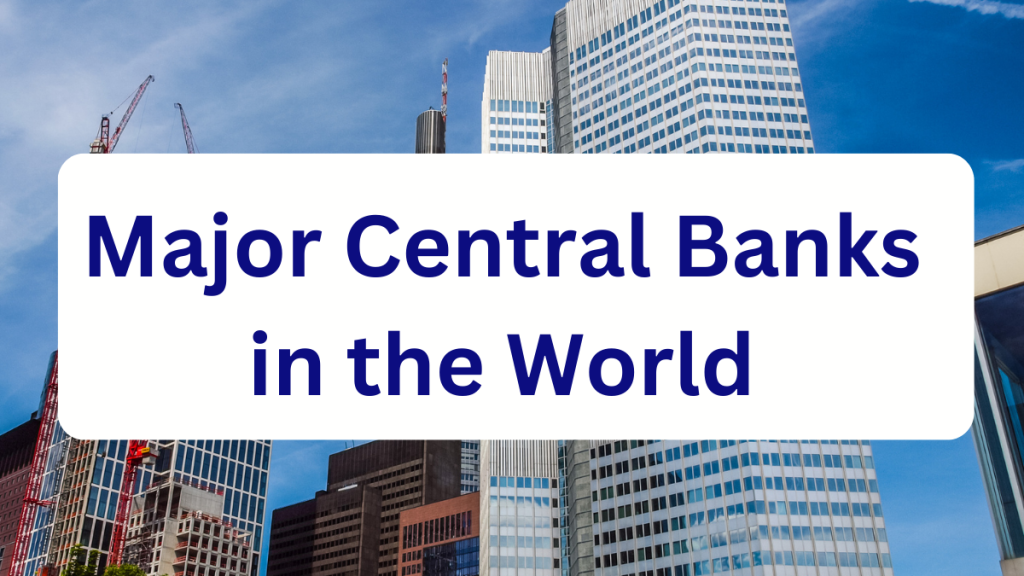Central Banks are really an organization for regulating the complications of the international financial system. They are assigned the duty of governing the monetary policies of a country, keeping the state economy stable, and ensuring good finances in a country. They shape the destiny of a country; they live their lives by the title-the “lender of last resort.” This blog explores major central banks and how they affect the world economy. Think of it as the conductor of a great symphony: Interest rates, currency values, and all other economic variables will work together nicely only when conducted by this elite institution. From the famous U.S. Federal Reserve to the lively European Central Bank of the Eurozone, all these institutions create policies that will ripple far and wide.
From the world-famous Federal Reserve in the United States to the fluctuating European Central Bank governing the Eurozone, each institution designs policy spread with distant ripples on the globe. They are not just the trustees of monetary policy, of course, but the very logo of financial stability, the gatekeepers of a country’s economical health. Their judgment reverberates through industry, adjusting inflation levels, job rates, and the scale of the whole domestic product. By exploring such vast business entities, the hugely optimistic can get a deeper understanding of the dynamics proliferating economic flexibility and managing the stressful storms and currents of global financing.

The blog shall take us through some of the biggest Central Banks worldwide, untangling the threads linking them to countries’ economic identities while understanding their choreography engagingly shaping the worldwide economy using central banks.
Major Central Banks of the World
Central Banks are the opposite links in the arduous chain of global finance connecting monetary management to economic stability. As promoters of a country’s financial splendour, they greatly dictate the economic path of that country. These central banks play a rather big role in determining the economic structure of any country. We have identified some major global central banks below; thus, we shall understand their specific roles toward the intricate fabric of the global financial system.
Federal Reserve System (Fed) — United States
The Federal Reserve is considered America’s central bank since it was created in 1913. It is established in Washington D.C. and operates independently within the federal government. Its task is to ensure low inflation, stable prices, and employment on a long-term sustainable basis-the maximum sustainable rates of employment. As among the world’s major Central Banks, the Federal Reserve greatly impacts the shaping of global economic interests and the financial markets.
Federal Open Market Committee: An important body of the Federal Reserve that meets regularly to decide monetary policy. Among its crest tools is the ability to influence the federal funds rate. Thus, the federal funds rate is quite a significant lever from the very standpoint that its adjustment impacts on interest rates in the whole U.S. financial system. Thus, over the years, FOMC actions, and with that accompanying policy actions taken, have produced great impacts. This could lead to decisions on cost of borrowing, investment decisions, and the overall economic environment for other economic activities taking place in the United States.
European Central Bank-ECB-Eurozone
The European Central Bank exists first and foremost as the cornerstone in constructing the economic architecture of the Eurozone. The Bank was born upon the Maastricht Treaty in 1998. Stationing its headquarters in Frankfurt, Germany, the very bank gives credence to the fact as being the central bank of the Eurozone. To cut the long story short, the Eurozone is a monetary union comprising different European countries that share the euro as their common currency. The ECB works in a somewhat peculiar framework-the so-called Eurosystem, which is an arrangement in which the ECB collaborates with national central banks of the Eurozone countries.
One of the main objectives assigned to the ECB is to promote price stability. This means keeping an eye on inflation, stimulating growth, and creating an environment conducive to employment in the Eurozone. As it moves through the multi-faceted expanse of monetary policy, the ECB combines standard and non-standard approaches. Setting interest rates is the primary tool, influencing the cost of borrowing, spending, and investment. The ECB also resorted to other unconventional approaches such as quantitative easing through the purchase of financial assets to inject liquidity into the financial system to promote economic activity.
Bank of Japan (BoJ) – Japan
Bank of Japan (BoJ) This is Japan’s central banking authority since its establishment in 1882, headquartered in Tokyo, a lively city. The BoJ maintains the economic tenor of Japan with the dual mandate of price stability and financial system stability. Increasingly, the BoJ has been recognized globally for its innovative monetization. Faced with mounting deflationary pressure and economic pressures, the Bank of Japan has set the pace for the use of unconventional tools.
BoJ is also engaged in enormous quantities of purchase transactions using the quantitative easing strategy to induce liquidity into the economy and foster investment. These extraordinary measures, specific to Japan, have sent ripples across global financial markets. The Bank of Japan makes this tremendous impact through its substantial foreign asset holdings, which in turn affect the international financial system such that BoJ’s holdings, in scale and scope, are central to determining global interest rate and currency values.
People’s Bank of China (PBOC)-China
The PBOC has been the central bank of the most populous country’s economy since its inception in 1948. Located in the heart of Beijing, the PBOC manages itself under the State Council, which gives it a central role in managing China’s intricate monetary policy. This involves a careful calibration to keep the value of the yuan relatively stable in the global currency market. China’s astounding economic rise over the last couple of decades has given the PBOC an arena on the global scene.
The rise as an economic superpower has further accentuated the importance of the PBOC’s decisions, which now have ramifications for the domestic financial arena in China and the highly complex dynamics that influence her international financial system. It can be said that PBOC’s actions bring about consequences that stretch far and beyond the borders of China, dictating various conditions of the global economy impacting trade relations and currency valuations. The PBOC has emerged as the backbone in steering an otherwise challenged and opportunity-filled framework of international finance as China now assumes the centre position in visions of the global economy.
Reserve Bank of India (RBI)-India
Founded in 1935, the Reserve Bank of India (RBI), located in the city of Mumbai, the heart of the country’s financial infrastructure, plays a major role in directing the economy of the nation. Apart from its imposing facade, the RBI works towards many ends, the most important of which is controlling inflation, the presence of which keeps equilibrium in any economy. Within the intricacies of monetary policy, the RBI utilizes various tools. It conducts inspection and supervision over the banking and financial system that exists in India.
The banking aspirants can expect the RBI to provide them with various opportunities, like RBI grade A Rajbhasha, RBI grade B, RBI assistant, RBI office attendant, RBI grade B DEPR, RBI grade B legal, and RBI non-CSG. These opportunities serve as an entry into promising career choices and also assist the RBI in its broader endeavors toward a sustained and progressive financial landscape for the good of India. In a nutshell, the Reserve Bank of India remains an important custodian of the country’s economic welfare, endowed with a wide-ranging history and estate of responsibilities.
Bank of England (BoE)-United Kingdom
Established in 1694, the Bank of England (BoE) boasts a rich legacy, standing as one of the oldest central banks globally. Nestled in the heart of London, the BoE is a linchpin in the United Kingdom’s financial architecture, wielding influence over monetary policy and economic stability. At the core of the BoE’s mandate is the formulation and implementation of monetary policy. With the responsibility of setting interest rates, the central bank plays a pivotal role in steering the nation’s economic trajectory.
The BoE’s commitment to stability extends beyond its monetary policy initiatives to encompass the broader financial system. By acting as a guardian of financial stability, the BoE navigates the intricacies of the banking sector, monitors potential risks, and implements measures to mitigate systemic vulnerabilities. One of the key decision-making bodies within the BoE is the Monetary Policy Committee (MPC). Comprising experts in economics and finance, the MPC convenes regularly to deliberate on interest rates.
Bank of Canada (BoC)-Canada
Founded in 1934, the Bank of Canada (BoC) is the backbone of Canada’s monetary and financial framework. The BoC is thus located in the capital, Ottawa, and has a clear mandate: to ensure price stability and support the economic and financial smarts of the nation. The BoC, just like its sister central banks, adopts a wide range of instruments to accomplish its goals. Among these, interest rate targeting is foremost since it allows the central bank to steer the economy across cycles and influence borrowing costs. The BoC must properly manipulate interest rates to promote sustainable economic growth while countering inflation pressures.
The BoC influences not just at home but across the foreign exchange market. In those forex-intervening sessions, the central bank aims to keep the Canadian dollar steady, creating a seamless environment for international trade and economic activities. Bank of Canada will continue to take on the driving role in the fast-evolving economic environment of Canada, changing its strategic approaches and policy agendas to the challenges of the day. The scale and depth of the decisions the Bank of Canada is making are, however, such that they will have effects far beyond Canada into the world of international financial markets, showcasing the intertwined existence of central banking with an increasingly interdependent world.
Swiss National Bank (SNB) – Switzerland.
In 1907, the Swiss National Bank (SNB) came into being; it stands for the cause of monetary and economic stability in Switzerland. It has headquarters in Bern but branches in Zurich and Geneva. It discharges its special duties beyond the horizon of classical central banking. Thus, by active contribution, it becomes indispensable for the whole process of formulation of economic policy in Switzerland. This includes the standard mandates of a central bank such as ensuring price stability, regulating the money supply while dissolving active participation in the broadest economic strategy of a country.
Despite employing conventional interest rates or reserve requirements, the interventions in the foreign exchange markets have made the SNB particularly famous for monetary policy regulations. Given Switzerland’s role as an international financial center where the CHF is considered a haven currency, all SNB interventions should be primarily guided by concerns of protecting the stability of the franc. Such interventions are invaluable in ensuring the reality that the exchange value of the Swiss franc is competitive in terms of international trade without excessive revaluation at the cost of an export-dependent economy.
Reserve Bank of Australia (RBA) – Australia.
The central bank of the Commonwealth of Australia is the Reserve Bank of Australia (RBA) which was established in 1960. The RBA’s head office is located in busy Sydney but other offices are scattered across the country. Part of the responsibilities for the RBA’s monetary policy borders on sustainable economic growth and restraint above the normal population level of inflation.
The bank note is printed by the RBA, the accrual of its integrity and reliability to the overall system of financial stability, and supervision thereof, as well as the risks within the financial sector. Any decision made by the RBA will translate into the interest rates, which would send ripples throughout the entire economy. Their announcements, especially those involving interest rates, have massive implications for inflation, employment and gross growth of the economy.
Bank of Brazil (BCB) – Brazil.
Created in 1964, this was the central monetary authority between Brazil’s financial system to be established, the Central Bank of Brazil, or simply BCB. It handles a big chunk of Brazil’s capital through its base in the country’s capital Brasília where it significantly contributes to the country’s stability and growth. In BCB, monetary policy appears to be the most important means, supplemented by other tools, to fight against such economic maladies.
The BCB oversees monetary policy even though it constitutes a power to issue money, hence making Brazil’s currency system sound, reliable and effective. The central bank is also concerned with stabilizing the banking and financial systems while safeguarding depositors’ and investors’ interests through supervision of banks and financial institutions.
South African Reserve Bank (SARB) – South Africa.
Established in 1921, the South African Reserve Bank (SARB) serves as the central banking institution for the Republic of South Africa. SARB occupies in Pretoria an active role regarding the economic stability of such a nation. Primary objectives of SARB shall be a price stability in South Africa and a general stability of the South African financial system. In balancing the support for growth and price stability, decisions on monetary policy will be taken by the central bank.
In pursuance of monetary policy goals, SARB adopts interest rates from an array of instruments, including non-conventional measures, to create the conducive economic atmosphere. The decisions of the South African Reserve Bank ripple through the financial markets of the country: affecting borrowing costs, the nature of investments, and the general performance of the economy. The South African Reserve Bank thus remains critical to ensuring stability and resiliency in an economic framework as South Africa undergoes a dynamic process of change.
Central Bank of Russia (CBR) – Russia.
Established in 1860, the Central Bank of Russia (CBR) is an institution at the bedrock of Russia’s financial system. The wide range of functions that the CBR undertakes makes it highly significant in the country’s economy. Money issues and ruble and monetary system integrity generally fall within the central bank’s concern. Additionally, the major portion of CBR’s attention is given to dealing with the stability monitoring of the whole financial system and to the improvement of the suppression of risks in financial institutions and depositor protection.
Because of its paramount impact in geopolitics and economics, any decision with CBR relevance, for sure, conjured disaster effects across its borders. Also, the central bank policies give signage on how the international financial markets allocate currencies, commodities and investments. The CBR will always be that important institution in traversing through the intricacies of world’s economic scene and will keep contributing to making national and international financial systems stable and resilient.
Prepping for RBI Exams with ixamBee
Preparing for RBI exams requires a comprehensive and strategic approach, and ixamBee serves as a valuable ally for aspiring RBI Officers on their journey to success. ixamBee provides an array of resources designed to equip candidates with the knowledge and skills needed to excel in various posts within the Reserve Bank of India. One of the standout features of ixamBee is its offering of Free Mock Tests, allowing candidates to simulate exam conditions and assess their performance. These mock tests are crafted to mirror the actual RBI exam patterns, providing invaluable insights into the question types, time management, and overall exam dynamics.
Additionally, ixamBee provides access to Previous Year Papers, offering a glimpse into the historical trends of RBI exams. Analyzing past papers aids candidates in understanding the exam’s nuances and helps them tailor their preparation accordingly. Online Courses offered by ixamBee are meticulously curated by experts in the field, covering the entire syllabus comprehensively. These courses provide structured learning modules, ensuring that candidates are well-versed in each subject. BeePedia, another resource from ixamBee, is a dedicated platform for preparing the General Awareness section.
Summing Up
This blog’s deep dive into major central banks reveals the profound responsibilities and influences they wield, from the robust Federal Reserve in the U.S. to the innovative People’s Bank of China. Each central bank shapes its nation’s economic destiny uniquely. Insight into their functions, tools, and policies is vital for those interested in finance, economics, or global affairs. As the financial landscape evolves, central banks will persist as key navigators of economic complexities and opportunities.
Dreaming of a career with the RBI Grade A exam? ixamBee is here to help you succeed! Boost your preparation with our top-notch RBI Assistant mock tests, RBI Grade B Phase 1 PYP, and a well-structured RBI Grade A\B online course designed by experts. For a focused approach, join our Target Banking online course and get the best study resources. Start your RBI Grade A journey with ixamBee today!
At ixamBee, we specialize in providing comprehensive online courses for government exams and online courses for government jobs. Our expertly designed courses for government jobs cater to a wide range of upcoming government exams. Whether you’re preparing for specific courses for government exams or seeking general guidance, ixamBee offers the resources like Beepedia previous year papers, SSC CGL, SSC CHSL, SSC MTS and other mock tests to succeed in exams like RBI Grade B, SEBI Grade A, NABARD Grade A, RRB NTPC, SSC MTS, NIACL Assistant, and more.
Also Read
List of Brands and their owner companies
The Comprehensive Guide to Different Types of Bank Accounts
UPSC Exam 2025: Full Form, History, Functions & Recruitment















